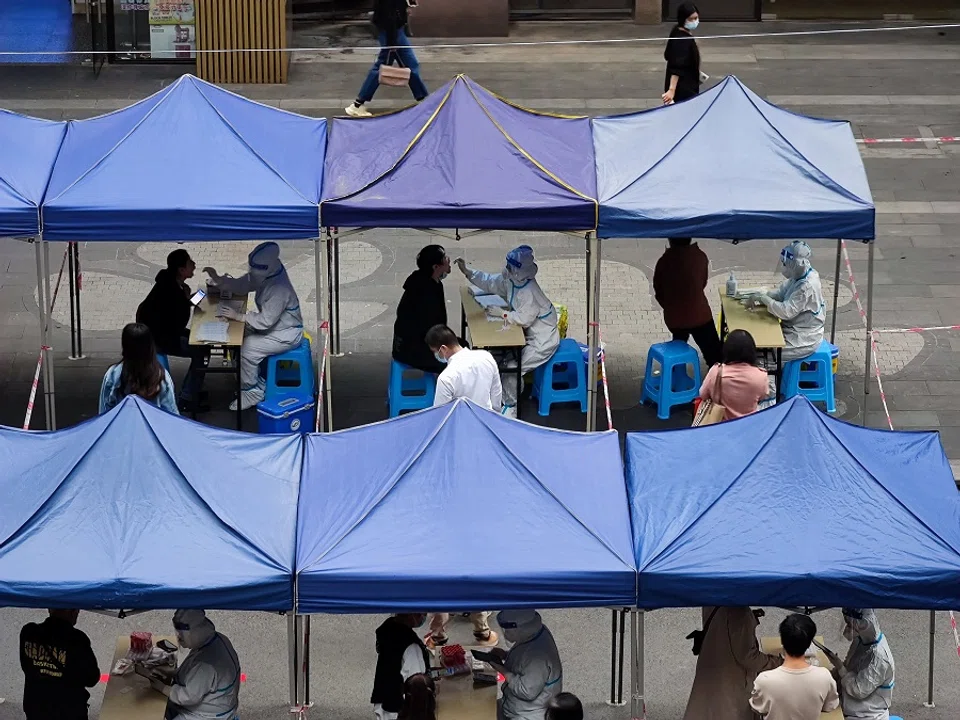Lockdowns or not: China's officials face new dilemma implementing anti-Covid measures
Chongqing is seeing its worst outbreak in three years, and although residential communities have been put under restrictions similar to 2020, the local authorities have not called it a citywide lockdown, leading to confusion. Zaobao correspondent Edwin Ong looks at how Chongqing is handling the latest wave, including a new regional coordination strategy proposed by party secretary Chen Min'er.

Since 1 November, Chongqing has seen its most serious Covid-19 outbreak in three years. Originating from the dance halls and open spaces in Shapingba district west of the main city, this latest wave has spread to nearly all of the 38 districts and counties, with local infections exceeding the thousand mark on 11 November. Several stores were closed for three days, and people were panic buying due to rumours of a lockdown, which the authorities refuted.
Lockdowns of communities but not the city
On 11 November, the central government announced 20 new measures to improve Covid-19 control, raising hopes of an easing of controls in the country. The new measures explicitly prohibit local governments from arbitrarily implementing additional measures such as "quiet management", restrictions and prolonged lockdowns, and warn of penalties for unnecessary measures leading to severe consequences.
In Chongqing, despite facing an "extremely severe situation" with "huge challenges to anti-Covid efforts", the authorities were hesitant to implement a widespread lockdown last week.
But it was inevitable. On 12 November, several districts in the main city announced increased social controls and ramped up closed management in residential communities. In addition, only one person from every household is allowed to buy necessities nearby every other day.
This is similar to the lockdown during Chinese New Year 2020, when the "mountain city" became an empty city, and residential communities even had metal sheet barricades put up to prevent residents from going out.
This approach of locking down communities but avoiding mentioning a city lockdown shows the problems with the current anti-epidemic model.

But even as communities are effectively in lockdown, the Chongqing authorities steered clear of mentioning "city lockdown", "sealing and control" and "quiet management". This approach of locking down communities but avoiding mentioning a city lockdown shows the problems with the current anti-epidemic model.
Some suspect that to circumvent the 20 new measures and avoid responsibility, the city officials have given the local communities the authority to implement lockdowns, which has the effect of adding more layers of controls. One netizen mocked that the officials have achieved something new in control measures, whereby "the government makes no announcement, while the community authority directs the estate, which in turn, announces quiet management".
Precise versus one-size-fits-all approach
On 12 November, the topic "Chongqing resident voluntarily goes into quiet management for seven days" became a top search on Weibo, seemingly starting a trend but also drawing criticism at the same time. The netizen who started the thread claimed to have stockpiled food for 20 days and decided to "go quiet and not make trouble for the government", sparking a round of blasting by disgruntled Chongqing residents.
Inevitably, there was chaos even amid lockdowns. A pregnant woman in Chongqing's Jiulongpo district reportedly suffered a miscarriage on 5 November because security measures in her residential community led to a four-hour delay in sending her to the hospital.

During a meeting on 12 November, Chongqing party secretary Chen Min'er called for "all-districts coordinative anti-epidemic efforts" in the main city to get out of this worst outbreak in three years. It involves coordination between "points, lines and areas", region, and dynamic policies and measures, to push for zero-Covid in the community.
But the coordinative strategy is basically old wine in a new bottle. Coordination between "points, lines, and areas" aims to control and contain outbreaks rapidly, preventing the virus from spreading outside the central city to the other districts and counties. Regional coordination refers to the coordinating mechanism between the various districts of Chongqing, improving communication, and providing mutual assistance in resources for quarantine and testing, to avoid an isolated approach to fighting Covid-19.
Only the coordination of dynamic policies and measures is relatively new, emphasising the timely adjustment of anti-Covid strategies in accordance with the central government's 20 new measures. Yang Lin, a Chongqing government spokesperson, said at a news conference that this strategy was rolled out after taking into consideration the new measures and Chongqing's Covid-19 situation so that lockdowns can be implemented and lifted swiftly and precisely.
... whenever a widespread outbreak occurs and Covid-19 cases start to skyrocket, local officials would return to one-size-fits-all measures and abandon the precision approach due to pressures to achieve zero-Covid.

In fact, while China has long emphasised a "precise" approach to contain the pandemic, whenever a widespread outbreak occurs and Covid-19 cases start to skyrocket, local officials would return to one-size-fits-all measures and abandon the precision approach due to pressures to achieve zero-Covid.
It remains to be seen whether Chongqing will fulfil its commitment to swiftly and precisely implement and lift lockdowns in the next few days.
Quelling public frustration
After Chongqing recorded nearly 3,000 new Covid-19 infections on 14 November, the proportion of new infections in the community started to decline. Li Pan, deputy director of the Chongqing Health Commission, evaluated on 15 November that the coordinative strategy was effective in the central areas, while movement and gatherings across different areas and within communities have been effectively controlled. However, he stressed that there is a significant number of undetected Covid-19 cases within the community, so Chongqing is still a long way from eradicating Covid-19.
China's daily new Covid-19 cases have recently climbed to the highest level since late April, and the original intention of the 20 new measures was to curb the recent anti-epidemic chaos in various regions, and more importantly quell public frustration.

However, anti-Covid measures continue to affect people's livelihoods and the local economies. The Covid-19 outbreak continues to worsen in Guangzhou, with Haizhu district, where most of the city's Covid-19 cases have been reported, placed under lockdown since 5 November.
Upset that their livelihoods have been affected and dissatisfied with the shortage of necessities, Haizhu residents were seen tearing down barricades, taking to the streets after dark and clashing with the police on 14 November in videos and images circulating online. Now, local authorities would have to ramp up efforts to allay public anger over the stringent anti-Covid measures.
Based on data released by Guangzhou authorities on 15 November, there were no severe or critical cases among the nearly 40,000 Covid-19 cases reported over the past 20 days in the current outbreak. Meanwhile, only three critical cases have been reported among Chongqing's more than 10,000 Covid-19 cases.

Zhang Boli, an academic from the Chinese Academy of Engineering, assessed that it is highly likely that the coronavirus is stabilising and becoming less deadly. With the low rate of critical cases and deaths, the introduction of relaxed measures is very timely and necessary, he added.
As several Chinese regions have begun to remove mass testing this week, all eyes are watching whether this chapter on Covid-19 lockdowns will finally close.
This article was first published in Lianhe Zaobao as "重庆到底封城了没?".
Related: What to think about when you think about China under Covid | China eases pandemic rules but people are worried | Can China connect to the outside world amid zero-Covid? | Chinese workers fleeing Foxconn highlights China's zero-Covid dilemma | No end to China's zero-Covid in the short term | CCP new leadership team's big task: Build market confidence amid zero-Covid



![[Photos] Fact versus fiction: The portrayal of WWII anti-Japanese martyrs in Taiwan](https://cassette.sphdigital.com.sg/image/thinkchina/3494f8bd481870f7c65b881fd21a3fd733f573f23232376e39c532a2c7593cbc)

